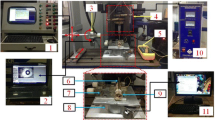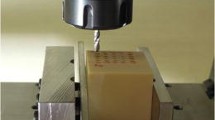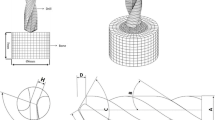Abstract
Mechanical and thermal damage due to cutting force and temperature rise during bone drilling plays a significant role in implant failure during osteosynthesis. High cutting force results in hole inaccuracy and weakens the stability between bone and implant. In comparison, temperature above 47 °C during drilling of bone results in the permanent death of regenerative bony cells consequences of thermal osteonecrosis. Microcracks at the drill site result in bone delamination and affect the holding strength at the bone-screw interface, resulting in implant failure. Accumulation of bone chips produced during drilling may cause chip clogging. The cutting force, microcracks, bone chip accumulation, and temperature rise are significant reasons for implant instability and revision surgery. Therefore, the present work uses the rotary ultrasonic bone drilling (RUBD) technique of the pig femur bone to monitor cutting force, temperature, microcracks and bone debris generated during the drilling. The results were also compared with conventional bone drilling (CBD). The twisted surgical drill bit was used during CBD and the diamond-impregnated tool was used during RUBD with the same diameters of 3.5 mm. The histopathological analysis was conducted at the drilled site to observe the tissue damage and the effect of heat generation on bone morphology. The output parameters were correlated, and the influence of cutting force on temperature rise, microcracks, and chip morphology was observed. This study showed that the increase in cutting force from 35.63 to 57.66 N in RUBD, and 54.83 to 78.7 N in CBD, resulted in a decrease in temperature rise by 51.5 and 32.7%, respectively. In contrast, the intensity of microcracks and chips size increased with the increase in cutting force for both RUBD and CBD techniques. Moreover, the RUBD technique reduces cutting force, temperature rise, microcracks and bone chip morphology as compared to CBD.






Similar content being viewed by others
References
Chen J, An Q, Zou F et al (2021) Analysis of low-frequency vibration-assisted bone drilling in reducing thermal injury. Mater Manuf Process 36:27–38. https://doi.org/10.1080/10426914.2020.1813891
Pandey RK, Panda SS (2015) Evaluation of delamination in drilling of bone. Measurement 37:657–664. https://doi.org/10.1016/j.medengphy.2015.04.008
Jamil M, Rafique S, Khan AM et al (2020) Comprehensive analysis on orthopedic drilling: a state-of-the-art review. Proc Inst Mech Eng Part H J Eng Med 234:537–561. https://doi.org/10.1177/0954411920911283
Mediouni M, Kucklick T, Poncet S et al (2019) An overview of thermal necrosis: present and future. Curr Med Res Opin 35:1555–1562. https://doi.org/10.1080/03007995.2019.1603671
Panda A, Sahoo AK, Rout AK (2016) Investigations on surface quality characteristics with multi-response parametric optimization and correlations. Alexandria Eng J 55:1625–1633. https://doi.org/10.1016/j.aej.2016.02.008
Gupta V, Pandey PM, Silberschmidt VV (2017) Rotary ultrasonic bone drilling: Improved pullout strength and reduce damage. Med Eng Phys 41:1–8. https://doi.org/10.1016/j.medengphy.2016.11.004
Agarwal R, Gupta V, Singh J (2022) Additive manufacturing-based design approaches and challenges for orthopaedic bone screws: a state-of-the-art review. J Brazilian Soc Mech Sci Eng 44:1–25. https://doi.org/10.1007/s40430-021-03331-8
Gok K, Erdem M, Kisioglu Y et al (2021) Development of bone chip—vacuum system in orthopedic drilling process. J Brazilian Soc Mech Sci Eng 43:1–11. https://doi.org/10.1007/s40430-021-02959-w
Gok K, Buluc L (2015) Development of a new driller system to prevent the osteonecrosis in orthopedic surgery applications. J Brazilian Soc Mech Sci Eng 37:549–558. https://doi.org/10.1007/s40430-014-0186-3
Pandey RK, Panda SS (2013) Drilling of bone: a comprehensive review. J Clin Orthop Trauma 4:15–30. https://doi.org/10.1016/j.jcot.2013.01.002
Augustin G, Davila S, Udilljak T et al (2012) Temperature changes during cortical bone drilling with a newly designed step drill and an internally cooled drill. Int Orthop 36:1449–1456. https://doi.org/10.1007/s00264-012-1491-z
Oliveira N, Alaejos-Algarra F, Mareque-Bueno J et al (2012) Thermal changes and drill wear in bovine bone during implant site preparation. A comparative in vitro study: twisted stainless steel and ceramic drills. Clin Oral Implants Res 23:963–969. https://doi.org/10.1111/j.1600-0501.2011.02248.x
Macavelia T, Olsen M, Schemitsch EH et al (2018) Biomechanical measurements of surgical drilling force and torque in human versus artificial femurs. J Biomech Eng 134:1–9. https://doi.org/10.1115/1.4007953
Fernandes MGA, Fonseca EMM, Natal RJ (2016) Thermal analysis during bone drilling using rigid polyurethane foams: numerical and experimental methodologies. J Brazilian Soc Mech Sci Eng 38:1855–1863. https://doi.org/10.1007/s40430-016-0560-4
Sugita N, Ishii K, Sui J, Terashima M (2014) Multi-grooved cutting tool to reduce cutting force and temperature during bone machining. CIRP Ann Manuf Technol 63:101–104. https://doi.org/10.1016/j.cirp.2014.03.069
Soriano J, Garay A, Aristimuño P, María L (2013) Effects of rotational speed, feed rate and tool type on temperatures and cutting forces when drilling bovine cortical bone. Mach Sci Technol 17:611–636. https://doi.org/10.1080/10910344.2013.837353
Sarparast M, Ghoreishi M, Jahangirpoor T, Tahmasbi V (2020) Experimental and finite element investigation of high—speed bone drilling: evaluation of force and temperature. J Brazilian Soc Mech Sci Eng 42:1–9. https://doi.org/10.1007/s40430-020-02436-w
Agarwal R, Jain V, Gupta V et al (2020) Effect of surface topography on pull-out strength of cortical screw after ultrasonic bone drilling: an in vitro study. J Brazilian Soc Mech Sci Eng 42:1–13. https://doi.org/10.1007/s40430-020-02449-5
Akhbar MFA, Sulong AW (2020) Surgical drill bit design and thermomechanical damage in bone drilling: a review. Ann Biomed Eng 48:1–28. https://doi.org/10.1007/s10439-020-02600-2
Agarwal R, Gupta V, Singh J (2022) A novel drill bit design for reducing bone-chip morphology in orthopaedic bone drilling. Mater Today Proc 52:2–7. https://doi.org/10.1016/j.matpr.2022.02.408
Wang Y, Cao M, Zhao X et al (2014) Experimental investigations and finite element simulation of cutting heat in vibrational and conventional drilling of cortical bone. Med Eng Phys 36:1408–1415. https://doi.org/10.1016/j.medengphy.2014.04.007
Harder S, Egert C, Wenz HJ et al (2013) Influence of the drill material and method of cooling on the development of intrabony temperature during preparation of the site of an implant. Br J Oral Maxillofac Surg 51:74–78. https://doi.org/10.1016/j.bjoms.2012.02.003
Gehrke SA, Neto HL, Mardegan FEC (2013) Investigation of the effect of movement and irrigation systems on temperature in the conventional drilling of cortical bone. Br J Oral Maxillofac Surg 51:953–957
Alam K, Silberschmidt VV (2014) Analysis of temperature in conventional and ultrasonically-assisted drilling of cortical bone with infrared thermography. Technol Health Care 22:243–252. https://doi.org/10.3233/THC-140813
Gupta V, Singh RP, Pandey PM, Gupta R (2020) In vitro comparison of conventional surgical and rotary ultrasonic bone drilling techniques. Proc Inst Mech Eng Part H J Eng Med 234:398–411. https://doi.org/10.1177/0954411919898301
Shakouri E, Sadeghi MH, Karafi MR et al (2015) An in vitro study of thermal necrosis in ultrasonic-assisted drilling of bone. Proc Inst Mech Eng Part H J Eng Med 229:137–149. https://doi.org/10.1177/0954411915573064
Singh G, Jain V, Gupta D, Sharma A (2018) Parametric effect of vibrational drilling on osteonecrosis and comparative histopathology study with conventional drilling of cortical bone. Proc Inst Mech Eng Part H J Eng Med 232:975–986. https://doi.org/10.1177/0954411918794983
Singh G, Jain V, Gupta D (2017) Multi-objective performance investigation of orthopaedic bone drilling using Taguchi membership function. Proc Inst Mech Eng Part H J Eng Med 231:1133–1139. https://doi.org/10.1177/0954411917735129
Gupta V, Pandey PM (2016) An in-vitro study of cutting force and torque during rotary ultrasonic bone drilling. Proc Inst Mech Eng Part B J Eng Manuf 232:1549–1560. https://doi.org/10.1177/0954405416673115
Gupta V, Pandey PM (2016) Experimental investigation and statistical modeling of temperature rise in rotary ultrasonic bone drilling. Med Eng Phys 38:1330–1338. https://doi.org/10.1016/j.medengphy.2016.08.012
Singh RP, Pandey PM, Mridha AR (2020) An in-vitro study of temperature rise during rotary ultrasonic bone drilling of human bone. Med Eng Phys 79:33–43. https://doi.org/10.1016/j.medengphy.2020.03.002
Agarwal R, Gupta V, Jain V (2021) A novel technique of harvesting cortical bone grafts during orthopaedic surgeries. J Brazilian Soc Mech Sci Eng 8:1–14. https://doi.org/10.1007/s40430-021-03064-8
Singh RP, Gupta V, Pandey PM, Mridha RA (2020) Effect of drilling techniques on microcracks and pull-out strength of cortical screw fixed in human tibia: an in-vitro study. Ann Biomed Eng 49:382–393. https://doi.org/10.1007/s10439-020-02565-2
Agarwal R, Mehtani H, Singh J, Gupta V (2022) Post-yielding fracture mechanics of 3D printed polymer-based orthopedic cortical screws. Polym Compos. https://doi.org/10.1002/pc.26620
Singh RP, Pandey PM, Behera C (2020) Effects of rotary ultrasonic bone drilling on cutting force and temperature in the human bones. Proc Inst Mech Eng Part H J Eng Med 234:829–842. https://doi.org/10.1177/0954411920925254
Singh RP, Pandey PM (2020) Comparison of conventional and ultrasonic drilling on cutting force in porcine and human femur. In: Proceedings of the ASME 2020 15th international manufacturing science and engineering conference MSEC2020. American society of mechanical engineers, pp 1–8
Singh RP, Pandey PM, Mridha AR, Joshi T (2020) Experimental investigations and statistical modeling of cutting force and torque in rotary ultrasonic bone drilling of human cadaver bone. Proc Inst Mech Eng Part H J Eng Med 234:148–162. https://doi.org/10.1177/0954411919889913
Singh RP, Pandey PM, Mir MA, Mridha AR (2022) Thermal changes during drilling in human femur by rotary ultrasonic bone drilling machine: a histologic and ultrastructural study. J Biomed Mater Res Part B Appl Biomater 110:1023–1033. https://doi.org/10.1002/jbm.b.34975
Pandey RK, Panda SS (2013) Optimization of orthopaedic driling: a Taguchi approach. Int J Mech Ind Eng 3:101–104
Gupta V, Pandey PM, Gupta RK, Mridha AR (2017) Rotary ultrasonic drilling on bone: a novel technique to put an end to thermal injury to bone. Proc Inst Mech Eng Part H J Eng Med 231:189–196. https://doi.org/10.1177/0954411916688500
Maani N, Farhang K, Hodaei M (2014) A Model for the prediction of thermal response of bone in surgical drilling. J Therm Sci Eng Appl 6:041005. https://doi.org/10.1115/1.4026625
Wang Y, Cao M, Zhao Y et al (2013) Experimental investigations on microcracks in vibrational and conventional drilling of cortical bone. J Nanomater 5:845205
Acknowledgements
Author would like to thank Dr. ARM, Department of Pathology and Dr. CB, Department of Forensic Medicine, AIIMS New Delhi, for their valuable support and suggestion during the work.
Funding
This research work was funded by SRISTI MOU BET. IITD/TIET Patiala AND SRISTI, Ahmedabad, Gujarat.
Author information
Authors and Affiliations
Corresponding author
Ethics declarations
Competing interests
All authors declare that they have no conflict of interest.
Ethics approval
Not required; In vitro study has been performed on the pig bone. Bone samples have been taken from the local butcher shop.
Additional information
Technical Editor: Adriano Fagali de Souza.
Publisher's Note
Springer Nature remains neutral with regard to jurisdictional claims in published maps and institutional affiliations.
Rights and permissions
About this article
Cite this article
Agarwal, R., Singh, R.P., Gupta, V. et al. Influence of cutting force on temperature, microcracks and chip morphology during rotary ultrasonic bone drilling: An in-vitro study. J Braz. Soc. Mech. Sci. Eng. 44, 301 (2022). https://doi.org/10.1007/s40430-022-03608-6
Received:
Accepted:
Published:
DOI: https://doi.org/10.1007/s40430-022-03608-6




